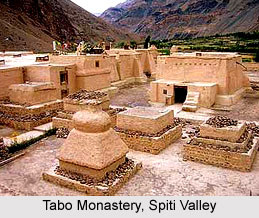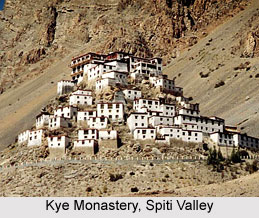 Monasteries of Spiti Valley are numerous and are significant centers of Buddhist pilgrimage in the country. Tabo Monastery, Kye Monastery, Tnagyud Gompa, Kibber Monastery and Kungri Monastery are some of the monasteries which are present in Spiti Valley in the Northern Indian state of Himachal Pradesh.
Monasteries of Spiti Valley are numerous and are significant centers of Buddhist pilgrimage in the country. Tabo Monastery, Kye Monastery, Tnagyud Gompa, Kibber Monastery and Kungri Monastery are some of the monasteries which are present in Spiti Valley in the Northern Indian state of Himachal Pradesh.
Tabo Monastery of Spiti Valley
Tabo Monastery is located in Tabo Village in Spiti Valley and is based at a distance of nearly 46 km south-east from the region of Kaza, Himachal Pradesh. This monastery is also popularly referred to as Tabo-Chos-Khor and implies `doctrinal circle`. There are 23 `chortens`, nine temples, an annex containing the bedchamber of a nun and a monk`s chamber. Beautiful wall paintings which are similar to those of Ajanta-Ellora paintings and sculptures embellish the interiors of this monastery.
Dhankar Monastery of Spiti Valley
Dhankar Monastery is an ancient monastery in Spiti Valley which is about 800 years old and is situated in Dhankar Village. The monastery is about 25 km east from Kaza area in Himachal Pradesh. Buddhist scriptures in Bhoti lingo and Buddhist paintings are existent inside its premises. The presiding deity of this monastery is `Dhyan Buddha` who is known as `Vairocana`.

Kye Monastery of Spiti Valley
Kye Monastery, also known as Ki Monastery or Ki Monastery is located at the summit of a hill at a height of nearly 4, 166 metres and is a Tibetan Buddhist Monastery. The `Lamas` imbibe religious training from this monastery which is known to be the largest monastery of Spiti Valley.
Tnagyud Gompa of Spiti Valley
This Gompa was constructed around the earlier part of 14th century and belongs to the sect of Sa-Kya-Pa. It is located in Comic Village in Spiti Valley. Tibetan scriptures known as `Tang-r-Gyud` are available in this Gompa, which comprises 87 volumes. Historical records claim that this Gompa was previously based near the village of Hilkkim, which was destroyed by an earthquake in the year 1975. Regional villagers are said to have moved the Gompa to its current location.
Kungri Monastery of Spiti Valley
Kungri Monastery is the second oldest monastery which is situated in Pin Valley and was constructed around 1300 AD. Evidences of Tantric cult are present in this monastery. This monastery belongs to the `Nyingma-pa Sect`. There are three rectangular blocks which are directed towards the eastern side, in this religious building. Sword dance is performed here by some buzhens.
Kibber Monastery of Spiti Valley
Kibber is located at an altitude of nearly 14, 200 feet, on top of a limestone rock. It is about 16 km away from Kaza in Himachal Pradesh. The monastery present here has been named after Serkang Rimpochhe of Tabo. This lama is believed to have passed his last breath in this monastery in the year 1983.



















